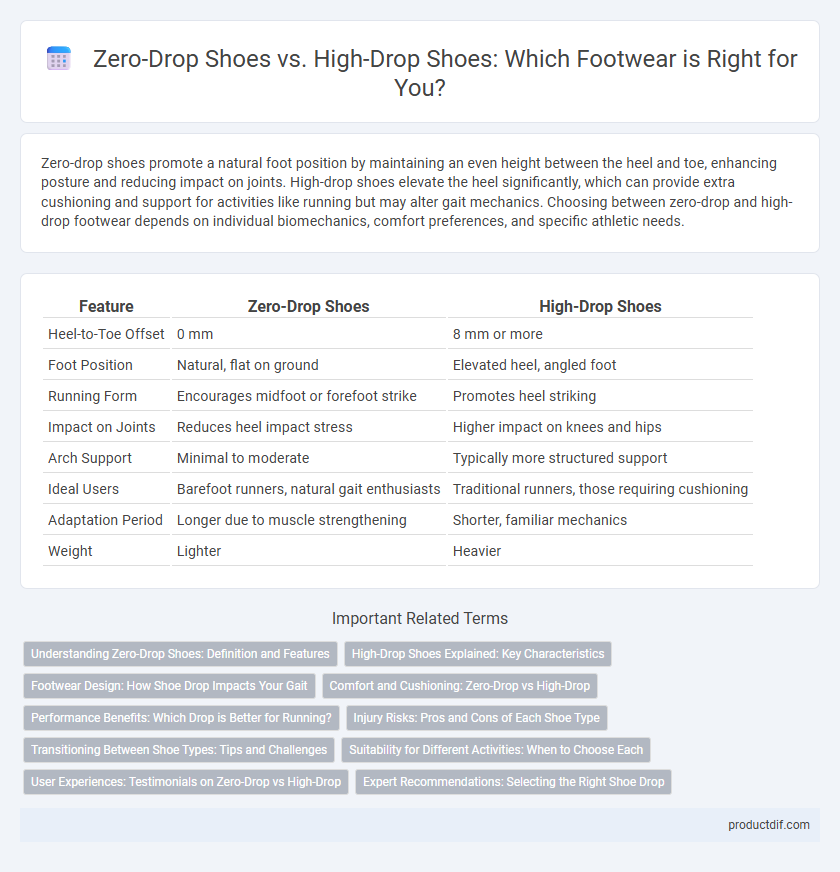Zero-drop shoes promote a natural foot position by maintaining an even height between the heel and toe, enhancing posture and reducing impact on joints. High-drop shoes elevate the heel significantly, which can provide extra cushioning and support for activities like running but may alter gait mechanics. Choosing between zero-drop and high-drop footwear depends on individual biomechanics, comfort preferences, and specific athletic needs.
Table of Comparison
| Feature | Zero-Drop Shoes | High-Drop Shoes |
|---|---|---|
| Heel-to-Toe Offset | 0 mm | 8 mm or more |
| Foot Position | Natural, flat on ground | Elevated heel, angled foot |
| Running Form | Encourages midfoot or forefoot strike | Promotes heel striking |
| Impact on Joints | Reduces heel impact stress | Higher impact on knees and hips |
| Arch Support | Minimal to moderate | Typically more structured support |
| Ideal Users | Barefoot runners, natural gait enthusiasts | Traditional runners, those requiring cushioning |
| Adaptation Period | Longer due to muscle strengthening | Shorter, familiar mechanics |
| Weight | Lighter | Heavier |
Understanding Zero-Drop Shoes: Definition and Features
Zero-drop shoes feature a sole with no height difference between the heel and the toe, promoting a natural foot position that mimics barefoot walking. These shoes typically offer a minimalist design with flexible soles and lightweight materials to enhance ground feel and encourage a midfoot or forefoot strike. Key benefits include improved posture, reduced impact on joints, and increased foot muscle engagement compared to traditional high-drop shoes.
High-Drop Shoes Explained: Key Characteristics
High-drop shoes feature a significant height difference between the heel and toe, typically ranging from 8mm to 12mm, designed to provide enhanced heel cushioning and support. These shoes are preferred for activities requiring additional shock absorption, such as running on hard surfaces, as they help reduce strain on the Achilles tendon. Commonly used in traditional running shoes, high-drop footwear supports heel strike patterns and offers stability for users with certain biomechanical needs.
Footwear Design: How Shoe Drop Impacts Your Gait
Zero-drop shoes maintain a consistent heel-to-toe height, promoting a natural foot strike and encouraging midfoot or forefoot landing, which can improve balance and reduce impact stress. High-drop shoes feature a raised heel, typically between 8-12 millimeters, which shifts weight forward and often leads to heel striking, altering gait mechanics and potentially increasing joint strain. Footwear design with differing drops directly affects posture, biomechanics, and overall running efficiency.
Comfort and Cushioning: Zero-Drop vs High-Drop
Zero-drop shoes provide a level platform that promotes a natural stride and even weight distribution, enhancing overall comfort for individuals seeking minimalist cushioning. High-drop shoes elevate the heel relative to the forefoot, offering increased cushioning and shock absorption, which benefits runners requiring additional support or heel protection. Comfort preferences depend on foot structure and activity type, with zero-drop favoring natural biomechanics and high-drop prioritizing enhanced heel cushioning.
Performance Benefits: Which Drop is Better for Running?
Zero-drop shoes promote a natural foot strike and improved running form by maintaining a level sole from heel to toe, which can enhance proprioception and reduce impact forces. High-drop shoes, with elevated heels, provide increased cushioning and support, benefitting runners who need extra shock absorption or have Achilles tendon concerns. Choosing the optimal drop depends on individual biomechanics and running style, as zero-drop favors natural movement while high-drop accommodates those requiring added heel protection.
Injury Risks: Pros and Cons of Each Shoe Type
Zero-drop shoes promote natural foot positioning and can reduce injuries related to overstressing the calves and Achilles tendon but may increase the risk of metatarsal stress fractures in unconditioned runners. High-drop shoes provide greater heel cushioning, which helps absorb impact and decrease strain on the plantar fascia but often contribute to increased risk of knee pain and shortened calf muscles due to altered running mechanics. Choosing between zero-drop and high-drop shoes depends on individual biomechanics, running style, and injury history to minimize the risk of overuse injuries.
Transitioning Between Shoe Types: Tips and Challenges
Transitioning between zero-drop shoes and high-drop shoes requires gradual adaptation to prevent injury and discomfort, emphasizing the importance of incremental wear time increases over several weeks. Pay close attention to calf and Achilles tendon soreness, as these areas often experience the most strain during the shift. Incorporating targeted stretching and strengthening exercises enhances foot and lower leg resilience, facilitating a smoother transition between different heel-to-toe drop footwear.
Suitability for Different Activities: When to Choose Each
Zero-drop shoes, with a heel-to-toe offset of 0 mm, are ideal for activities requiring natural foot motion and improved proprioception, such as running on trails or practicing yoga. High-drop shoes, featuring a heel-to-toe offset of 8-12 mm, offer enhanced cushioning and support, making them suitable for road running, hiking, and sports involving high-impact movements. Choosing between zero-drop and high-drop shoes depends on the activity's demand for stability, cushioning, and natural gait mechanics.
User Experiences: Testimonials on Zero-Drop vs High-Drop
Users of zero-drop shoes report improved posture and reduced joint pain, highlighting a natural foot strike and increased ground feedback. Conversely, testimonials from high-drop shoe wearers emphasize enhanced cushioning and support, particularly benefiting runners with heel-strike patterns or those prone to foot fatigue. Overall, individual experiences suggest that shoe drop preferences significantly impact comfort, injury prevention, and running efficiency.
Expert Recommendations: Selecting the Right Shoe Drop
Experts recommend zero-drop shoes for natural foot alignment and improved posture, especially beneficial for runners seeking a minimalist experience. High-drop shoes often suit individuals needing extra heel cushioning and support, particularly those with heel pain or Achilles tendon issues. Choosing the right shoe drop depends on personal biomechanics, running style, and comfort preferences, with gradual transition crucial to avoid injury.
Zero-drop shoes vs High-drop shoes Infographic

 productdif.com
productdif.com